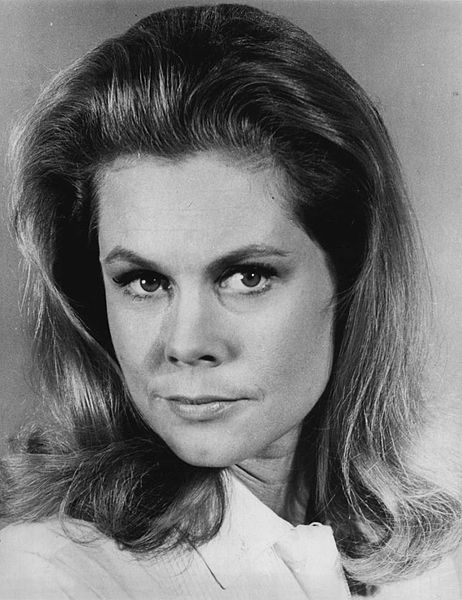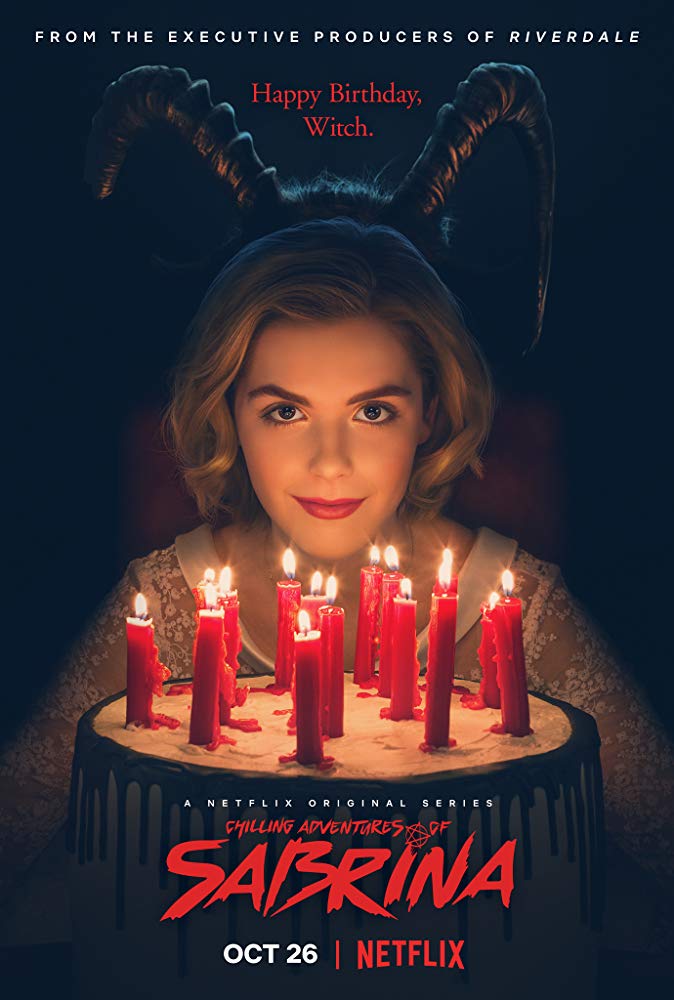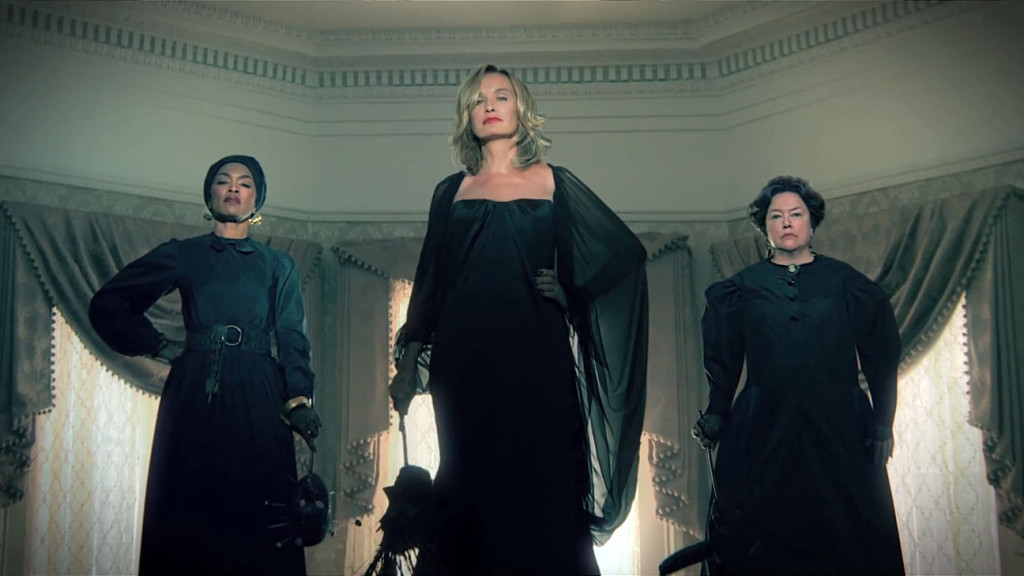
TV witches have always captivated me. As a child, I would sit cross-legged in front of the screen, completely spellbound by reruns of Samantha Stephens from Bewitched on Nick-at-Nite. I remember watching her effortlessly clean the house with a twitch of her nose, never realizing that there was something deeper going on in these portrayals of witches. At the time, they seemed like fun, harmless characters. But as I grew older, and particularly as I delved into occult arts myself, I started seeing these witches as reflections of societal changes.
They weren’t just whimsical characters; they were symbols of deeper transformations in how we understand power, gender, and the supernatural. It’s interesting to look back and see how witches on TV have been portrayed over the decades—first as playful, domestic figures and later as rebellious, complex beings. These changes mirror shifts in our culture, offering insight into our evolving relationship with power and femininity.

Publicity photo of Elizabeth Montgomery as Samantha Stephens in Bewitched [Screen Gems]
As an anthropologist, I’ve come to see witches through a broader, more nuanced lens. Early Western ethnographers, while studying the practices of other cultures, often brought with them their own ethnocentric biases about magic and religion. Their interpretations were shaped by centuries of European history, particularly the witch persecutions during the Inquisition and Reformation, which cast a long shadow over public perceptions of witchcraft. These historical events influenced how witchcraft was understood, often framing it as dangerous or subversive, a legacy that still echoes in modern depictions of witches.
Ronald Hutton once described witches as individuals who upset the natural order, reflecting society’s fears of “transgression and otherness.” That statement has always stuck with me. Witches have historically occupied the margins of society, embodying our collective anxieties about those who break the rules. On TV, these characters often serve as a mirror for how we feel about rebellion and the unknown. From Samantha Stephens in Bewitched to Sabrina Spellman in The Chilling Adventures of Sabrina, witches on TV have evolved alongside our culture, offering a fascinating reflection of changing values.
Take Bewitched, for instance. When I first watched it as a child, I didn’t understand the broader cultural implications. It was only later, studying the show as an adult, that I realized how significant Samantha’s character really was. Bewitched premiered in 1964, during a time when women were expected to conform to very specific domestic roles. Samantha, a suburban housewife with magical powers, was expected to hide her abilities to keep the peace in her marriage. Anthropologist Mary Douglas explored how societies manage dangerous or deviant powers, particularly in women, and Bewitched fits this pattern perfectly. Samantha’s powers—while central to her identity—had to be contained within the home. It was a perfect metaphor for the simmering tension of the 1960s, as women began to push back against restrictive gender roles. Watching Samantha wield magic only to fold laundry or cook dinner feels, in retrospect, like a commentary on the limitations placed on women’s potential at the time.
But what really fascinated me was how Bewitched seemed to tap into the broader cultural anxiety surrounding women’s liberation. Heather Greene notes that the show subtly reflected societal discomfort with powerful women, portraying Samantha’s magic as something to be “contained.” As I grew older and started to analyze these portrayals more critically, I realized that Bewitched was more than just a fun show—it was a reflection of how we were grappling with the changing roles of women in society. Samantha’s magic, like many women’s potential at the time, had to be tamed and hidden, only permissible within the context of her marriage.
Fast forward to the 1990s, and witches took on a different role in shows like Sabrina the Teenage Witch. I remember watching Sabrina as a teenager, and it felt like a totally different vibe from Samantha’s world. Sabrina, played by Melissa Joan Hart, wasn’t hiding her powers for the sake of a man — she was learning to manage them in the midst of teenage life. Her powers weren’t dangerous; they were fun, playful, and tied to the challenges of growing up. Watching Sabrina juggle her magic and her life as a high school student felt incredibly relatable, even though I didn’t have spells at my disposal! Sabrina the Teenage Witch came out at a time when third-wave feminism and “girl power” were starting to make waves, and Sabrina’s character fit right into that narrative of young women coming into their own.
Greene mentions that Sabrina the Teenage Witch reflected the 1990s’ cultural fascination with self-discovery and empowerment, and that really resonates with me. As an anthropologist, I see Sabrina’s journey as a metaphor for the liminal space of adolescence, a concept explored by Victor Turner. In Turner’s work, the “liminal” refers to those transitional periods of life, like adolescence, when we’re neither here nor there. For Sabrina, magic was a tool to navigate that uncertainty. Instead of representing something to be feared, her powers were an extension of her identity, and the show celebrated that. Watching it now, I can see how it reflected a broader cultural shift towards embracing female autonomy and empowerment in a way that wasn’t possible in Samantha’s era.
And then came Charmed, which overlapped with my own first entries into magic and Paganism. What fascinated me about this show was how it tied magic to ideas of sisterhood and collective strength. The Halliwell sisters weren’t just witches—they were “The Charmed Ones,” destined to protect the world from evil. Watching them navigate their powers, which were tied to their familial bond, felt deeply feminist. Greene describes the Halliwells as “warrior witches,” and I think that perfectly captures their role in the cultural landscape of the late 1990s and early 2000s. This was a time when feminism was becoming more mainstream, and Charmed reflected that by positioning witches as powerful women who used their magic to fight injustice.
What struck me about Charmed was how it embraced the idea of witches as empowered figures. Unlike Samantha or even Sabrina, the Halliwell sisters didn’t need to hide their powers—they used them openly to fight the forces of evil. This shift reflects broader changes in how we view women and power. Instead of fearing magic, Charmed celebrated it as a tool for good, tying it to feminist ideals of autonomy and strength. Academically I see Charmed as reflecting the rise of spiritual feminism and the reclaiming of witchcraft as a source of empowerment for women, much like the contemporary Wiccan and modern Pagan movements, which has also been noted by Helen A. Berger.

The Chilling Adventures of Sabrina [Netflix]
In recent years, witches have taken on darker, more rebellious roles in shows like American Horror Story: Coven and The Chilling Adventures of Sabrina. These series dive deep into witchcraft’s most dangerous and defiant aspects. Watching Coven, I couldn’t help but marvel at how far TV witches had come since the days of Samantha Stephens. The witches in Coven are raw, unapologetically powerful, and fiercely determined to claim their place in the world. It makes me wonder how many young Pagans today were first drawn to the occult by the image of black umbrellas and the search for the next Supreme.
The Chilling Adventures of Sabrina follows a similar trajectory, with Sabrina Spellman confronting occult forces while outright rejecting patriarchal authority. Her journey isn’t about blending in, but about questioning societal norms and forging her own path. Both shows reflect a growing cultural interest in the darker, more rebellious aspects of magic, where witches stand as symbols of resistance and empowerment rather than just fantastical figures.
Watching these newer portrayals of witches, I can’t help but marvel at how significantly their representation has evolved over time. No longer contained figures confined to the domestic sphere, today’s witches emerge as symbols of rebellion, power, and, at times, danger. This evolution mirrors broader societal changes, reflecting our ongoing grappling with questions of identity, autonomy, and the complexities of power dynamics in an increasingly fragmented world.

A promotional image from American Horror Story: Coven. [FX]
As an anthropologist, it fascinates me to see how these characters serve as cultural touchstones that reveal shifting norms around gender and authority. Historically, as Hutton has described, witches have often occupied the margins of society, as seen during the European witch hunts, where fear of female power led to widespread persecution. This historical context informs our understanding of modern portrayals, where witches assert their autonomy and challenge patriarchal structures.
Moreover, contemporary witchcraft narratives highlight the intersectionality of modern feminism, with witches representing not just female empowerment but also a broader critique of societal norms. Today they emphasize themes of sisterhood, agency, and resistance, inviting audiences to question traditional power structures and explore the nuanced complexities of identity. By reimagining witches as multifaceted characters, we gain new insights into the ongoing dialogue around gender and power, underscoring the relevance of these narratives in our current cultural landscape.
References
- Berger, H. A. (1999). A community of witches: Contemporary neo-paganism and witchcraft in the United States. University of South Carolina Press.
- Douglas, M. (1966). Purity and danger: An analysis of concepts of pollution and taboo. Routledge.
- Greene, H. (2021). Lights, camera, witchcraft: A critical history of witches in American film and television. Llewellyn Publications.
- Hutton, R. (1999). The triumph of the moon: A history of modern pagan witchcraft. Oxford University Press.
- Turner, V. (1969). The ritual process: Structure and anti-structure. Aldine Publishing.
The Wild Hunt is not responsible for links to external content.
To join a conversation on this post:
Visit our The Wild Hunt subreddit! Point your favorite browser to https://www.reddit.com/r/The_Wild_Hunt_News/, then click “JOIN”. Make sure to click the bell, too, to be notified of new articles posted to our subreddit.